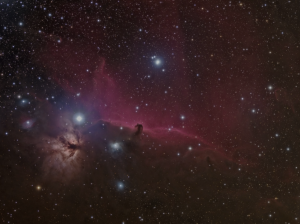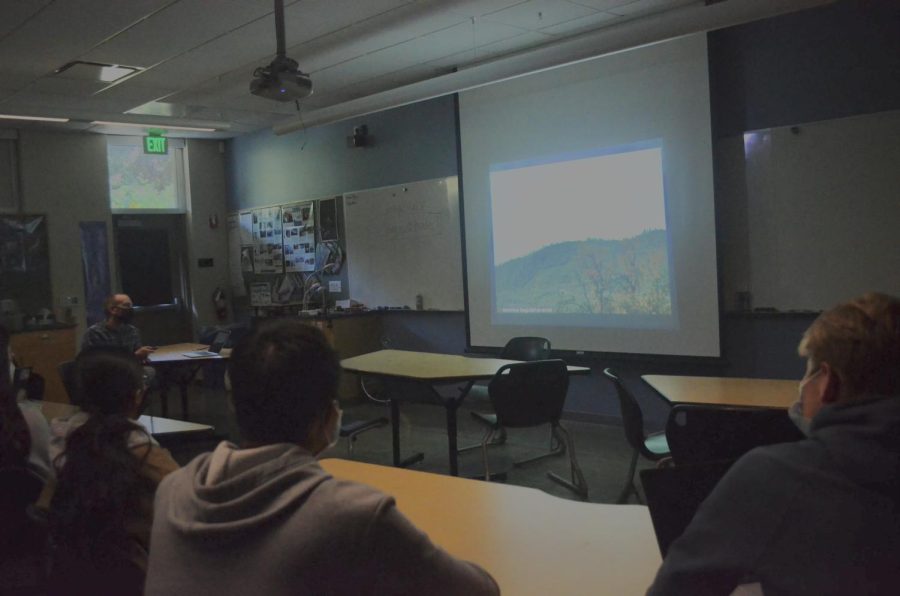Astronomy Club dives into details of astrophotography in speaker event
Upper school physics and research teacher Chris Spenner discusses the lessons he learned in astrophotography during the Astronomy Club’s workshop on Thursday. During the workshop, Spenner emphasized how certain astrophotography techniques are more challenging and can take several years to master.
December 14, 2021
Astronomy Club invited upper school physics and research teacher Chris Spenner to lead an astrophotography workshop last Thursday during long lunch.
The workshop was the first part of a series intended to introduce different astronomy topics to club members. The club postponed their original plan to hold a solar telescope viewing workshop on Tuesday due to overcast weather, but they hope to host the event next semester.
During the astrophotography workshop, Spenner projected photos he took of stars, the moon, comets and more onto a whiteboard. He then discussed the techniques he used when taking the pictures, such as stacking exposures, which includes combining several images taken of the same object but with different lighting settings.
He also offered advice on which techniques were more beginner-friendly and which ones would take more time to master. Though Spenner developed his skills in astrophotography over the past fifteen years, this was his first time presenting his photos in front of an audience.
“I hope [students] got a little inkling of my reverence for the night sky and why I do [astrophotography],” Spenner said. “Sometimes a fox randomly comes up and sits next to me while I’m doing my photography, or sometimes I hear an owl come flying right over my head. Just being out in nature is part of the joy of doing it.”

Upper school physics teacher Dr. Mark Brada, adviser of Astronomy Club, noted the visually engaging aspect of astrophotography.
“The thing that I took away the most from it was this idea of the three-dimensionality of an astrophotograph, how in a single photograph you can have objects that are at vastly different distances,” Brada said. “I think it was a great way of getting the students interested, besides just how naturally beautiful a lot of the images were.”
Throughout Spenner’s presentation, students asked questions about how to achieve certain effects in photos and made comments on interesting details they noticed in his work. Club co-president Emily Zhou (12), felt that the topic catered to a wide audience, which was something that she, along with other club officers, took into consideration when organizing the event.
“Even if you’re not really interested in the technical side of [astrophotography], just seeing the images is really awe-inspiring because there’s so much out there that you haven’t explored,” Emily said. “I think that’s really amazing.”
Astronomy Club plans to hold future workshops focused on technical skills such as the computer science behind filtering an astrophotograph.


















![“[Building nerf blasters] became this outlet of creativity for me that hasn't been matched by anything else. The process [of] making a build complete to your desire is such a painstakingly difficult process, but I've had to learn from [the skills needed from] soldering to proper painting. There's so many different options for everything, if you think about it, it exists. The best part is [that] if it doesn't exist, you can build it yourself," Ishaan Parate said.](https://harkeraquila.com/wp-content/uploads/2022/08/DSC_8149-900x604.jpg)




![“When I came into high school, I was ready to be a follower. But DECA was a game changer for me. It helped me overcome my fear of public speaking, and it's played such a major role in who I've become today. To be able to successfully lead a chapter of 150 students, an officer team and be one of the upperclassmen I once really admired is something I'm [really] proud of,” Anvitha Tummala ('21) said.](https://harkeraquila.com/wp-content/uploads/2021/07/Screen-Shot-2021-07-25-at-9.50.05-AM-900x594.png)







![“I think getting up in the morning and having a sense of purpose [is exciting]. I think without a certain amount of drive, life is kind of obsolete and mundane, and I think having that every single day is what makes each day unique and kind of makes life exciting,” Neymika Jain (12) said.](https://harkeraquila.com/wp-content/uploads/2017/06/Screen-Shot-2017-06-03-at-4.54.16-PM.png)








![“My slogan is ‘slow feet, don’t eat, and I’m hungry.’ You need to run fast to get where you are–you aren't going to get those championships if you aren't fast,” Angel Cervantes (12) said. “I want to do well in school on my tests and in track and win championships for my team. I live by that, [and] I can do that anywhere: in the classroom or on the field.”](https://harkeraquila.com/wp-content/uploads/2018/06/DSC5146-900x601.jpg)
![“[Volleyball has] taught me how to fall correctly, and another thing it taught is that you don’t have to be the best at something to be good at it. If you just hit the ball in a smart way, then it still scores points and you’re good at it. You could be a background player and still make a much bigger impact on the team than you would think,” Anya Gert (’20) said.](https://harkeraquila.com/wp-content/uploads/2020/06/AnnaGert_JinTuan_HoHPhotoEdited-600x900.jpeg)

![“I'm not nearly there yet, but [my confidence has] definitely been getting better since I was pretty shy and timid coming into Harker my freshman year. I know that there's a lot of people that are really confident in what they do, and I really admire them. Everyone's so driven and that has really pushed me to kind of try to find my own place in high school and be more confident,” Alyssa Huang (’20) said.](https://harkeraquila.com/wp-content/uploads/2020/06/AlyssaHuang_EmilyChen_HoHPhoto-900x749.jpeg)







